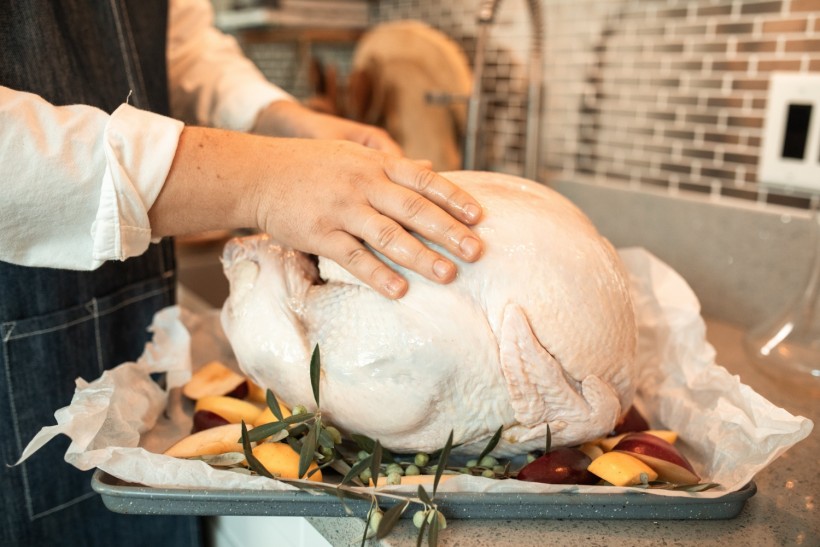Throughout its history, Thanksgiving has been a holiday that is celebrated annually in both the United States and Canada. While observance varies between the two nations, this day serves the same purpose of commemorating the previous year's harvest and other benefits, albeit on two distinct dates. The followers of Jesus are credited with initiating the observance; in 1621, they referred to it as their "First Thanksgiving."
Food safety is always our first concern when preparing food for a get-together with our friends and family. To avoid any food-borne illness that may affect our family members, here are some of the food safety tips during Thanksgiving.
1. Wash Your Hands, Not the Turkey
 (Photo : Pexels/RDNE Stock project)
(Photo : Pexels/RDNE Stock project)

Make sure to wash your hands thoroughly before cooking or handling any food. As per Contagion Live, the United States Department of Agriculture (USDA) advises against individuals washing their turkeys in the sink of their kitchen. A remarkable 68% of consumers still engage in this practice, as found by a survey conducted by the FDA about food safety.
People who reportedly wash their turkeys in the sink run the danger of spilling microorganisms up to three feet around the kitchen, potentially contaminating the environment. Moreover, pathogens cannot be removed from poultry simply by washing it to destroy microorganisms. The turkey must also be cooked thoroughly to the appropriate internal temperature.
2. Safely Thaw Your Turkey
According to the Centers for Disease Control and Prevention (CDC), there are three safe methods for defrosting turkey: in the microwave, in the refrigerator, or in a sink containing cool water that is replaced every 30 minutes. As mentioned, it is okay to consume your turkey as long as it is frozen and stored in the freezer; however, while you are thawing your turkey, it must be done at a non-hazardous temperature.
Never allow the turkey to defrost on the counter for more than two hours since doing so could result in the poultry reaching an unsafe temperature. Bacteria will multiply rapidly as soon as the temperature hits what the CDC refers to as the "danger zone," which is between 40°F and 140°F.
Read Also: Easy Thanksgiving Dinner Ideas to Impress Your Family
3. Stuff Safely
As per the USDA, the safest method for preparing stuffing is in an individual dish. Despite the turkey being cooked to the appropriate temperature, the stuffing within it might not have attained an equivalent temperature necessary to eradicate all pathogens. But if stuffing the turkey is a part of your holiday ritual, the CDC advises waiting until the last minute to do so. Use a food thermometer to ensure the middle of the stuffing has reached 165 °F. In addition, once you have removed the turkey from the oven, you should wait twenty minutes before removing the filling from the turkey's cavity. It will allow the stuffing to finish cooking for a few more minutes.
4. Cook Thoroughly
Prepare your turkey so that a thermometer inserted into the thickest part of its thigh registers 165 °F. Determine the internal temperature of three areas using a food thermometer at the thickest portion of the breast, the wing's interior portion, and the thigh's innermost portion. Even if the turkey has a temperature indicator that pops up, the USDA advises using a food thermometer to verify that the bird has achieved 165 °F in all three areas. Furthermore, if you are only cooking a turkey breast instead of a whole turkey, use the food thermometer to ensure that the internal temperature reaches 165 °F in the thickest portion of the breast.
5. Store and Heat Leftovers Safely
Foods that need to be refrigerated should not be removed for more than two hours at a time. Microorganisms known as Clostridium perfringens may multiply in cooked dishes allowed to cool to room temperature. Bacterial contamination is attributed to it as the second most prevalent cause.
Accordingly, the months of November and December are the most typical times for Clostridium perfringens incidents, and these outbreaks are frequently connected to foods commonly offered during the holidays, such as turkey and roast beef. Thus, the most prominent symptoms are nausea, vomiting, and abdominal cramping that occur between 6 and 24 hours after eating.
Related Article: Thanksgiving Dinner: 5 Kitchen Mistakes To Avoid When Preparing a Feast
To keep up with the latest news on trending recipes, food safety, and more, follow Food World News!









